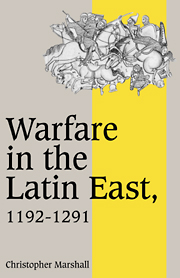Book contents
- Frontmatter
- Dedication
- Contents
- List of Illustrations
- Acknowledgements
- List of abbreviations
- Map
- Introduction: the Study of Warfare in the Latin East
- Chapter 1 Warfare and the History of the Latin East, 1192-1291
- Chapter 2 The Latin Armies
- Chapter 3 Castles and Strongpoints
- Chapter 4 Battles
- Chapter 5 Raiding Expeditions
- Chapter 6 Sieges
- Conclusion
- Appendix Scouts, Spies and Traitors
- Bibliography
- Index
Chapter 3 - Castles and Strongpoints
Published online by Cambridge University Press: 07 September 2023
- Frontmatter
- Dedication
- Contents
- List of Illustrations
- Acknowledgements
- List of abbreviations
- Map
- Introduction: the Study of Warfare in the Latin East
- Chapter 1 Warfare and the History of the Latin East, 1192-1291
- Chapter 2 The Latin Armies
- Chapter 3 Castles and Strongpoints
- Chapter 4 Battles
- Chapter 5 Raiding Expeditions
- Chapter 6 Sieges
- Conclusion
- Appendix Scouts, Spies and Traitors
- Bibliography
- Index
Summary
INTRODUCTION
The Latin states were able to defend their territories against external threat and civil disorder by means of the army and the strongpoints. The dependence of the kingdom’s troops on the fortified sites is striking. The constant problems caused by a manpower shortage, except at the time of a crusade, meant that the gathering of a large field army was rarely, if ever, possible in the Latin East during the thirteenth century. Most of the available soldiers, rather, were dispersed among a series of individual garrisons which were, to some extent, augmented by forces such as the Military Orders, the French regiment or groups of peregrini. The relationship of a garrison to its strongpoint thus provided the basis of the kingdom’s military strategy and the framework for much of the military history of the period.
This relationship is illustrated by two documents dating from the 1240s. In September 1244, just before the battle of La Forbie, the principal ecclesiastics of the Holy Land, the leaders of the Military Orders and a number of lords wrote to Innocent IV explaining the difficulties caused by a lack of troops: ‘the knights of the land are dispersed in all directions, near the castles they are guarding; they cannot easily be assembled because they are unable to leave the castles undefended…’. Ascalon was besieged following the battle of La Forbie. The garrison ‘realised that they were unable to have any help or aid from the Christians who were in the country, because the latter were themselves entirely occupied in guarding their own fortresses’. So they fled from Ascalon, abandoning it to the Muslims. The limited numbers of troops available were therefore employed in the defence of strongpoints. However, the division of the Latin army into a number of garrisons did not simply influence the kingdom’s defensive strategy. Strongpoints could also perform a more aggressive role, as a base for raids into hostile territory, for example, and in a general sense to ‘threaten’ the enemy. Their physical presence, and that of the garrisons within them, were the most obvious expressions of Latin dominance in the region.
- Type
- Chapter
- Information
- Warfare in the Latin East, 1192–1291 , pp. 93 - 144Publisher: Cambridge University PressPrint publication year: 1992
- 1
- Cited by

